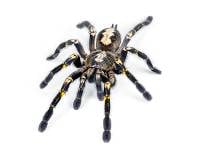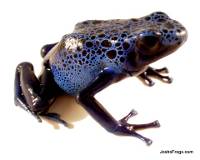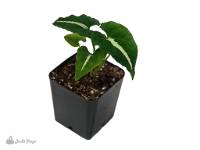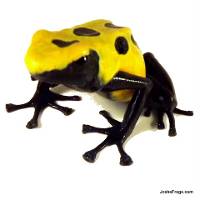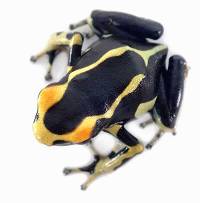Josh's Frogs
Why you should buy from us
Cobalt Blue Tarantula - Cyriopagopus lividus | 1 inch (Captive Bred)
Cobalt Blue Tarantula - Cyriopagopus lividus | 1 inch (Captive Bred)
$49.99 $69.99
About This Product
Environmental Caution:
When a damp environment has too little air circulation, this can lead to an anaerobic environment. Where the typical aerobic bacteria helps keep certain types of waste from building up, they are instead replaced by anaerobic bacteria whose waste is more likely to be toxic and harmful. This is often accompanied by a strong swampy smell.
To guard against anaerobic environments, it is important to monitor and control moisture in the environment as well as air quality. One way to maximize both is to have plentiful live plants as the byproduct of photosynthesis is oxygen and water. Springtails can help keep the substrate aerated and break down waste so that the beneficial bacteria can more easily turn it into plant food.
Defining Characteristics:
- This species is known for having a short temper
- The iridescent blues and greens on this tarantula’s exoskeleton are breathtaking
- This species tends to spend most of their time hiding underground. They are sometimes referred to as a “pet hole”.
Name: Cyriopagopus lividus is commonly known as the Cobalt Blue Tarantula. The epithet, lividus translates from the Latin as “bruised”. This refers to the blue and green colors of this tarantula.
Recommended Enclosure Size & Setup: Cyriopagopus lividus is a fossorial species, meaning this animal will spend a lot of time underground and may need additional substrate to burrow. Surface area of the enclosure should be no less than two times the spider's diagonal leg span in one direction and three times the diagonal leg span in the other. We recommend against allowing your fossorial spider more than two times their diagonal leg span as head space above their substrate as a fall from any higher could result in serious injury.
The enclosure should be tall enough to accommodate 2-3 inches of substrate for slings and 5+ inches for adults. ABG mix, coco cradle, or Dig-It are good substrate options, but our Pet Bug Team prefers ABG all the way!
Temperature (°F): This species thrives in the mid 70s to low 80s, so a temperature close to 80 degrees is ideal. Temperatures regularly dipping below 65 or spiking above 85° should be avoided.
A thermometer is recommended to keep an eye on temperatures in the enclosure.
Humidity: These spiders thrive in a humid environment, so the recommended ambient humidity should stay between 55 and 70%. This can be achieved by making sure the substrate is always at least slightly moistened. Depending on your location, you may need tools such as a humidifier to maintain this environment.
The enclosure sides and décor should be spritzed at least lightly around twice a week to provide your animal droplets to drink from and keep humidity up, do not spray your spider directly. A hygrometer is a great way to monitor the humidity for your animal and see any needed adjustments.
Size: At the time of sale, these spiders are at least 1 inch. Adults grow to be 5-6 inches, with females being significantly larger than males.
Age: These spiders will be 1-2 years old. Females can live 18 to 20 years while males usually live 4 to 6.
Feeding: These spiders are currently eating two to three 1/4 inch crickets, once a week. There are a variety of appropriate prey items that you can offer, such as roaches, waxworms, black soldier fly larvae, hornworms, and silkworms. Consider feeding your prey items with our gutload formula to give your pet well-rounded nutrition.
We recommend that the prey items not be much longer than the tarantula's “head” is wide. Larvae are an exception—our larvae are harmless. Since they are very high in fat, they're not the best staple diet, however they make a great weight gain supplement.
Remove uneaten prey items after 24 hours, these may stress your animal out or endanger the spider during molting. Never attempt to feed a freshly molted tarantula less than a week after their molt to prevent injury to the spider. Depending on its age, the hardening process could take anywhere from 48 hours all the way up to a week.
Sexing: Due to age, Cyriopagopus lividus sold by Josh’s Frogs are sold as unsexed.
Color/Pattern: As adults, this species lives up to its name. While it is infamously difficult to capture in a photograph, the iridescent blues on this specimen are stunning.
Social Behavior: Cyriopagopus lividus is not a sociable animal and should be housed as an individual. Attempts at cohabitation can result in cannibalism.
This species spends most of its time underground. It can occasionally be seen strolling about, outside its burrow in the late evening or early morning.
While Cyriopagopus lividus does not have medically significant venom, it is more than willing to give it to you. This species is very defensive and quick to strike to defend themselves.
Natural Range: Cobalt Blues are native to Myanmar and over the border into Thailand. These spiders inhabit the tropical rainforests of Southeast Asia, where they construct deep burrows and generally only leave them in search of food.
History in the Hobby: This species first became available at the start of this century.
Links of Interest:
- Arachnoboards: a community of spider enthusiasts that will be able to or have already answered almost any question you can think of with regards to tarantulas.
Still not sure if Cyriopagopus lividus from Josh's Frogs is the right pet for you? Read the reviews below and see what other customers are saying!
Shipping
After placing an order containing a live animal, you will receive a scheduling email containing our JotForm scheduling link to schedule your new pet's delivery date.
With this scheduling link, you will be able to schedule your order's delivery up to 30 days in advance. You will be able to choose a date of delivery for Tuesday-Saturday (Saturday arrival depends on the carrier's service availability) with the estimated time of arrival generally being 12pm, or 4:30pm for more rural areas. Overnight lows must be above 40°F to ship directly to you (or above 30°F for FedEx Ship Center/UPS Customer Center pickups) as well as below 90°F by estimated time of arrival.
If you require further assistance, or prefer to talk to one of our Customer Service agents, please feel free to reach out to our [email protected] email or our phone line 1-800-691-8178.
Other Customers Also Bought
Customer Reviews
Review data
5 star reviews
- 0%
4 star reviews
- 0%
3 star reviews
- 0%
2 star reviews
- 0%
1 star reviews
- 0%



